The Bay Trail Preview: Intel Atom Z3770 Tested
by Anand Lal Shimpi & Brian Klug on September 11, 2013 12:00 PM ESTIn addition to showing Bay Trail running on a Windows 8.x platform, Intel showed us a “pre-beta” version of the platform running Android 4.2.2. I have to emphasize that the build they showed us definitely seemed pre-beta, as there was some instability, but overall the build was good enough to run some tests on and get a feel for. Intel made it clear that they do have a lot more work to do on their Android build before it’s considered close to final quality than the Windows equivalent.
Inside Android we can still see the CPU state table data and how long the cores are sitting in each performance state still, despite this now being managed in-silicon on Bay Trail. In addition Android sees the 2.39 GHz Z3770 boost frequency and reports it. I didn’t see any strange behavior on the device while running tests and watching CPU frequency, if anything the reference design platform stayed at the maximum boost frequency even with four cores plugged in for an impressive amount of time. Of course this is a tablet so there’s more TDP to play around with compared to a phone.
Depending on where you were in the Android UI, there was some definite stutter, but I’m told this is a result of an issue with Dalvik not allocating threads to cores properly that Intel is still tuning, something which you can see plays itself out as well in the AndEBench Java test that runs in Dalvik. The launcher especially had some stutter, but Intel claimed they were aware of it and that final performance in areas like that would be dramatically improved. Regardless of the state of Bay Trail’s Android port, it affords us the opportunity to look at performance through our pretty standard benchmark suite.
On the CPU side for Android we’re still limited to just a few tests that rely on a combination of native code and stuff that runs inside the browser. That means AndEBench, JavaScript benchmarks, and part of Vellamo.
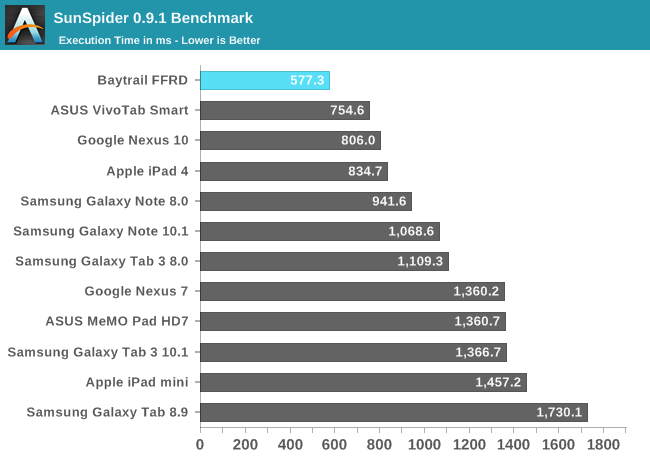
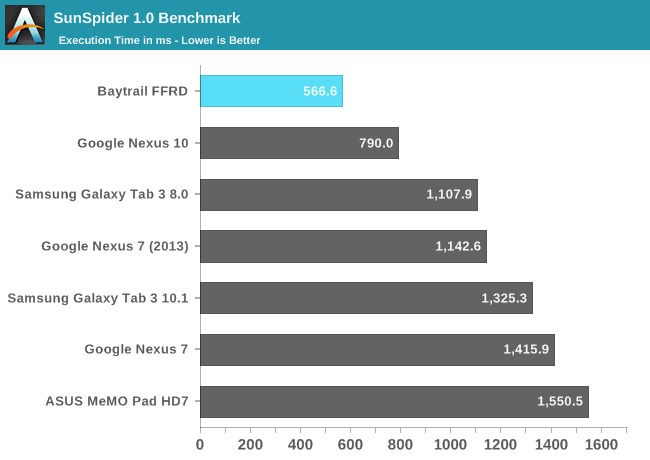
Sunspider has been a regular staple but in recent time has become an exercise in browser JavaScript engine optimization rather than actual performance. Nevertheless the FFRD takes the crown in both 1.0 and 0.9.1 (we have more tablet data from the 0.9.1 version so I replicated it here).
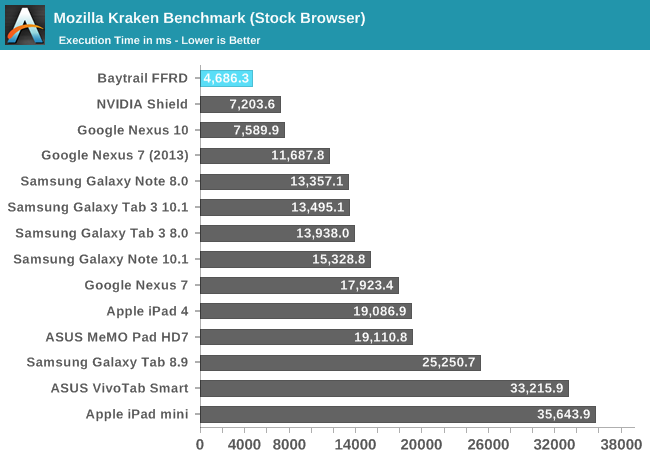
Kraken is another JavaScript benchmark which hasn’t quite been an optimization target everyone has gone after lately, and it’s also longer, which makes it a bit more reliable. Once again Bay Trail takes the crown here with notably faster JS engine performance.
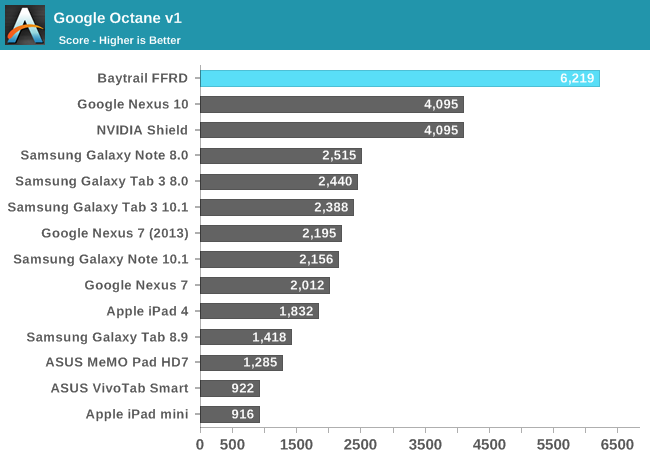
Google Octane is another JS test that isn’t quite as platform optimized yet, here there’s once again dominance by Bay Trail with just over a 50 percent higher score.
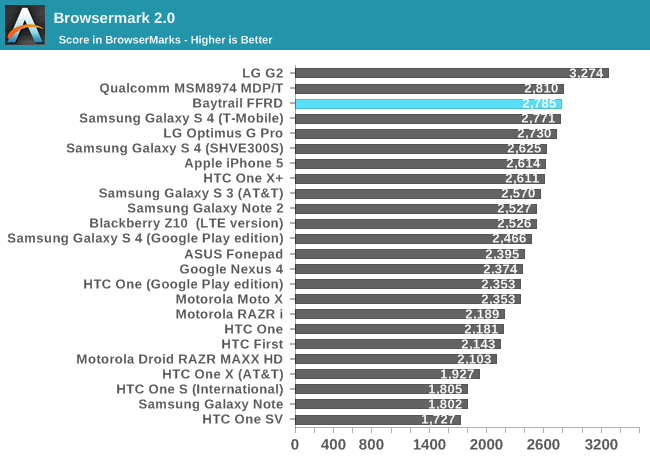
Browsermark has a combination of both JS tests and other web related performance metrics. Here the Bay Trail platform lags behind the 8974 based devices slightly. This isn’t a raw JavaScript benchmark again but rather a more holistic web browsing performance test, so it’s interesting to see Bay Trail a bit behind here.
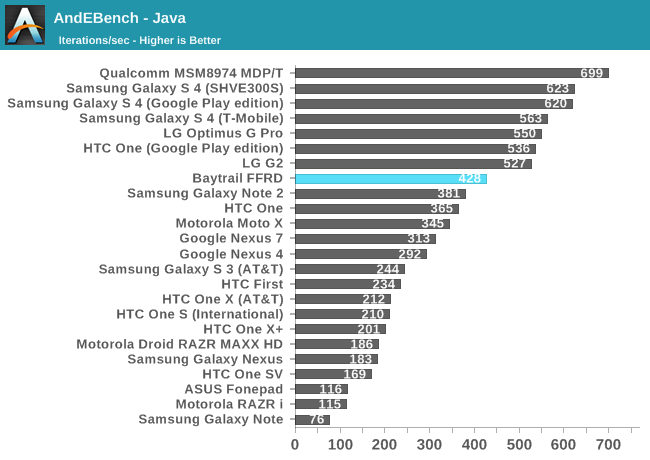

AndEBench is a combination native compiled microkernel benchmark (indicative of NDK application performance) that also runs a very similar workload atop Dalvik like a normal Android Java application. Here we can see what Intel was talking about when they said they have more work to do getting Dalvik working properly at dispatching threads to appropriate cores, hopefully the Java number will climb considerably. The native test also shows a lead over the competition.
GPU Performance
While Bay Trail clearly leads on the CPU side, its GPU performance is more middle of the road - at least among the higher end SoCs. In 3DMark Bay Trail's GPU performance is aided by the more CPU bound nature of the benchmark, but here Intel is able to beat the Snapdragon 600. Snapdragon 800 on the other hand pulls ahead by around 35%.
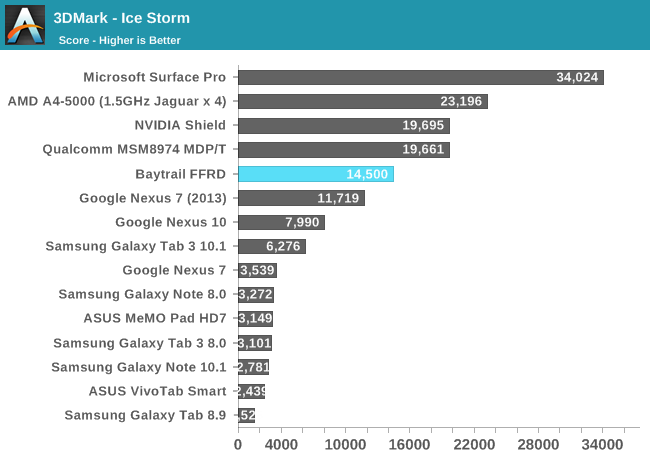
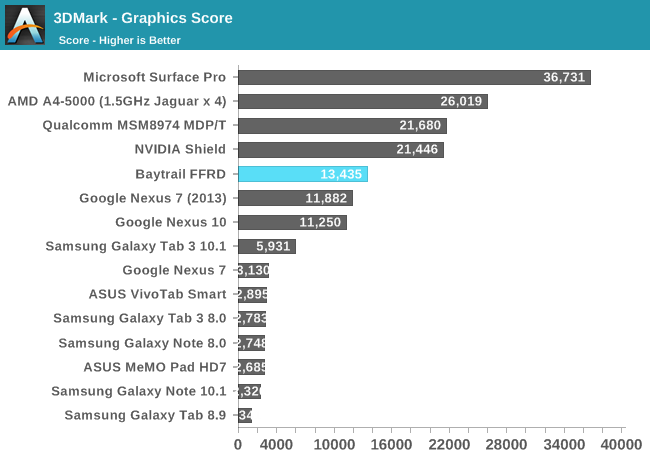
The 3DMark Physics test is effectively a CPU test, which once again plays to Bay Trail's strengths. Here it's faster than Snapdragon 800 and Cortex A15. Only Ivy Bridge is quicker in a tablet.
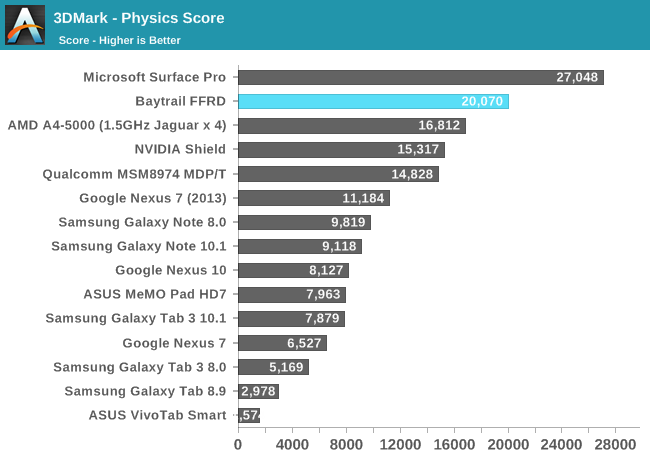
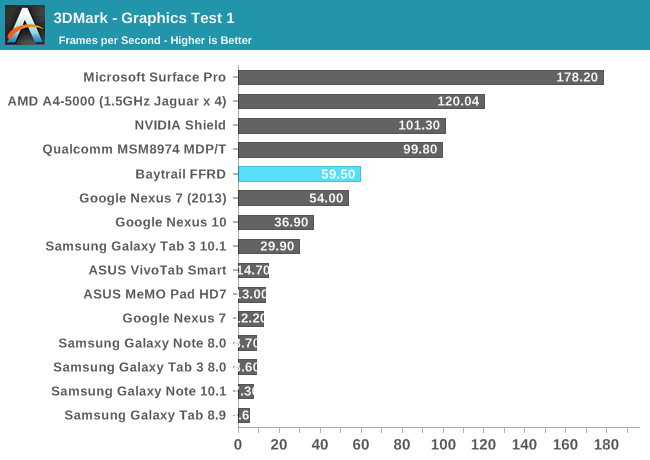
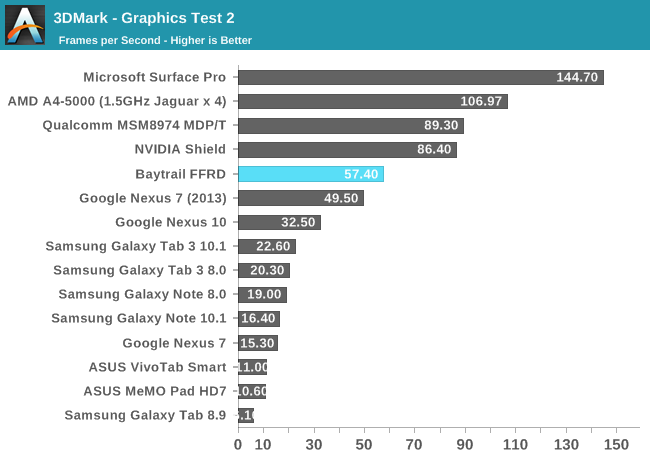
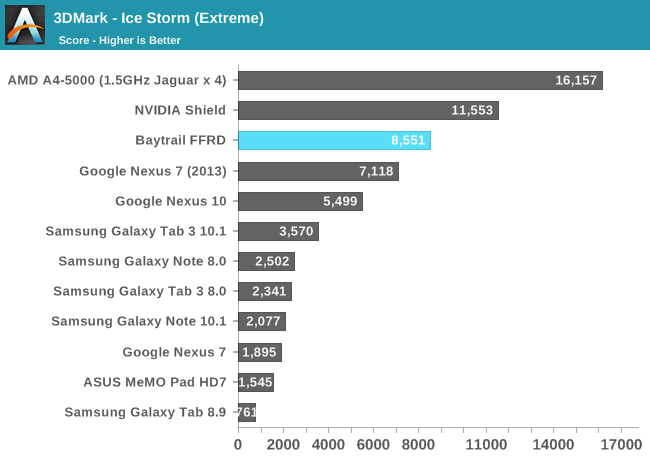
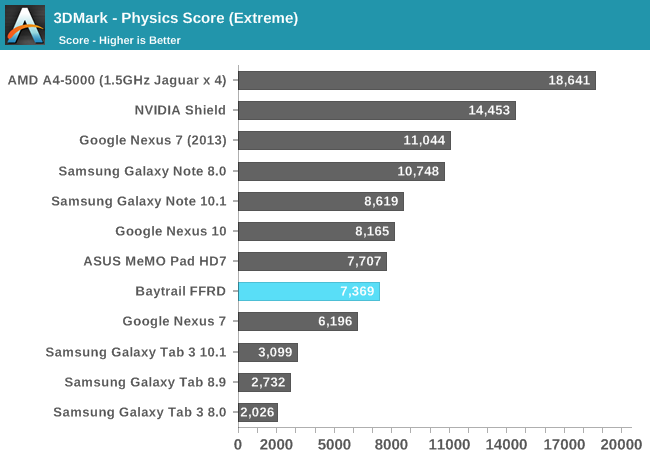
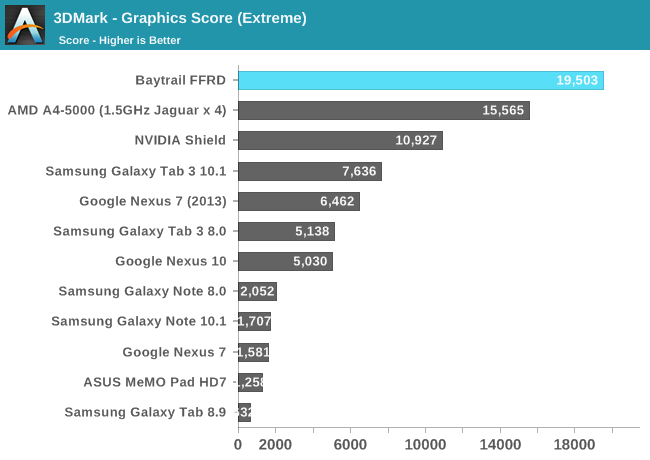
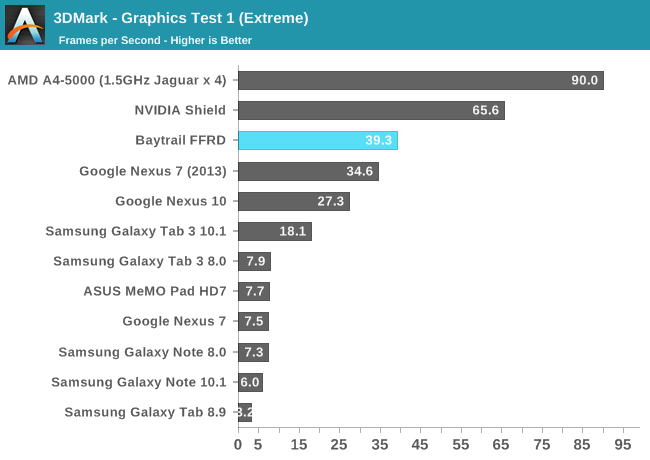
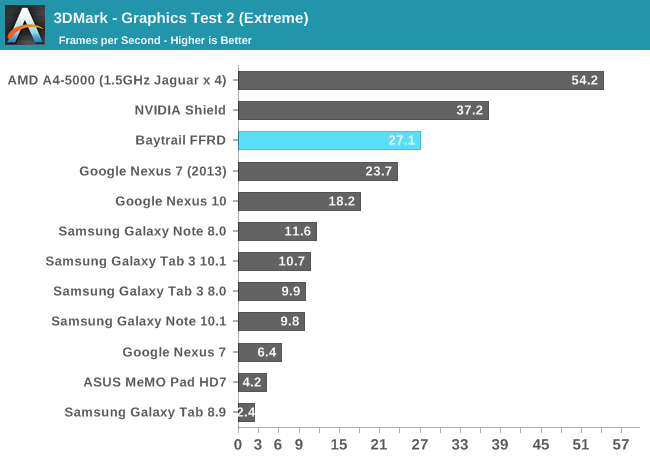
Basemark X
Basemark X is a bit more GPU bound than 3DMark, and we also have iOS data here so we can put Bay Trail's performance in better perspective. Here Bay Trail is a bit slower than the iPad 4, and clearly Tegra 4 and Snapdragon 800. Intel's GPU in Android is measurably quicker than Adreno 320/S600 though.
Bay Trail's onscreen performance is penalized by the FFRD's extremely high native resolution.

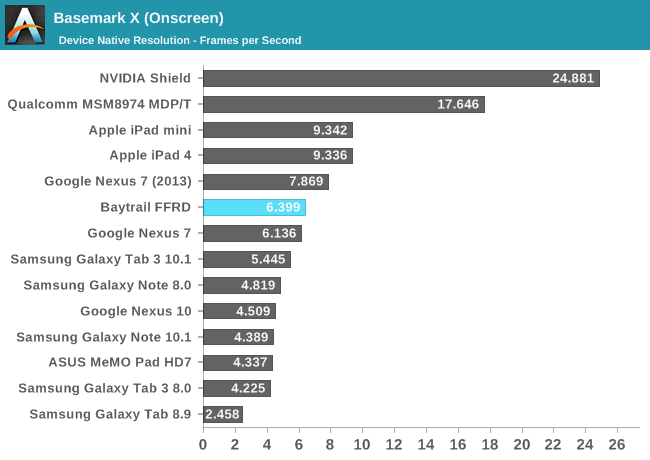
GLBenchmark 2.7
The more interested GLBenchmark numbers, T-Rex HD, show Bay Trail just behind the iPad 4 in performance. It's definitely not bad at all but clearly not industry leading.
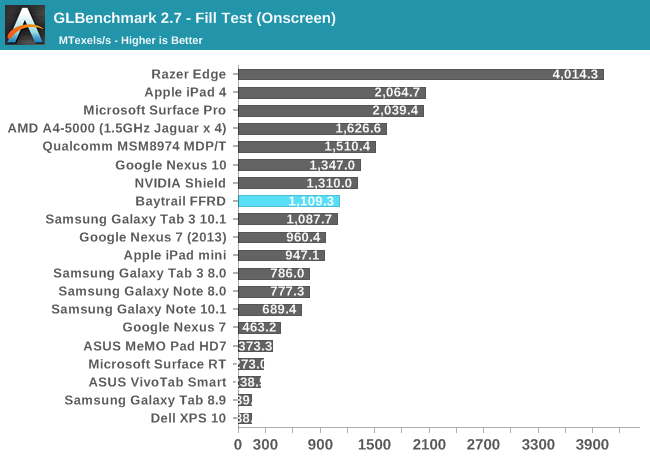
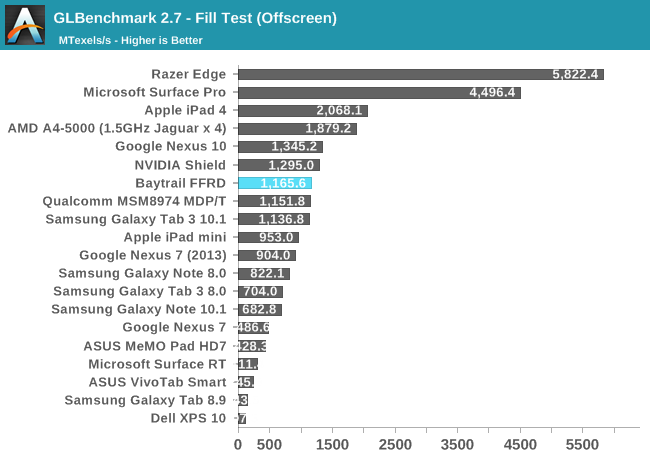
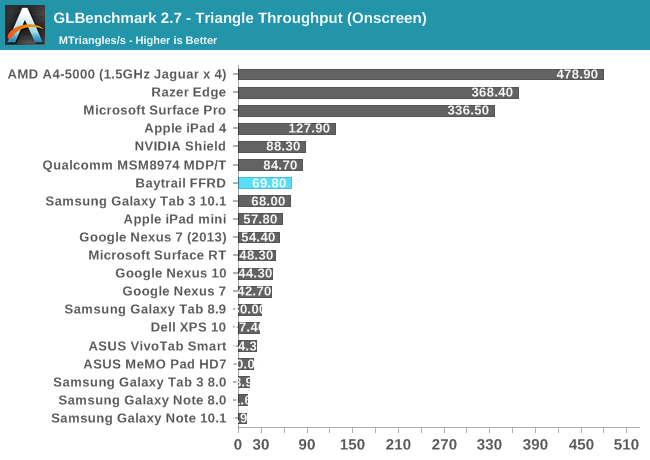
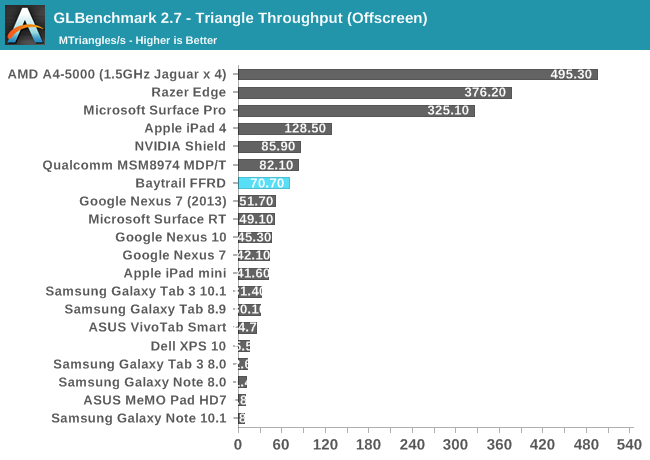
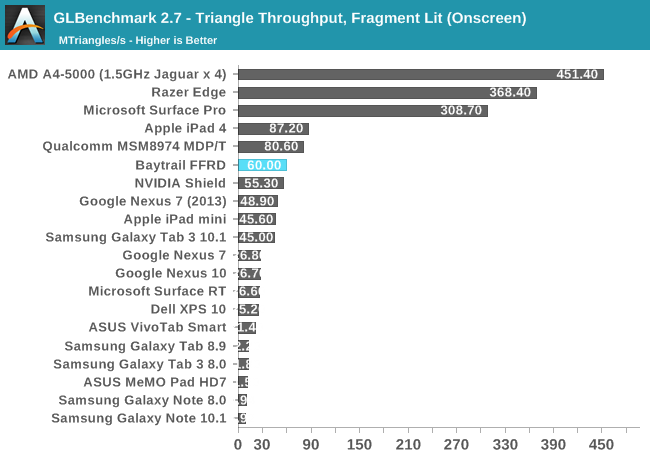
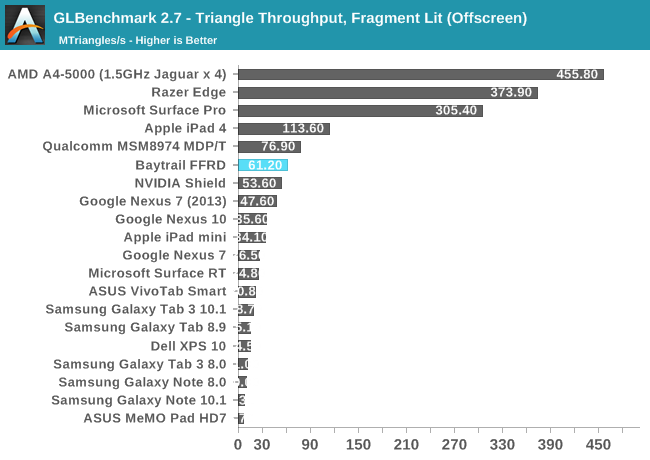
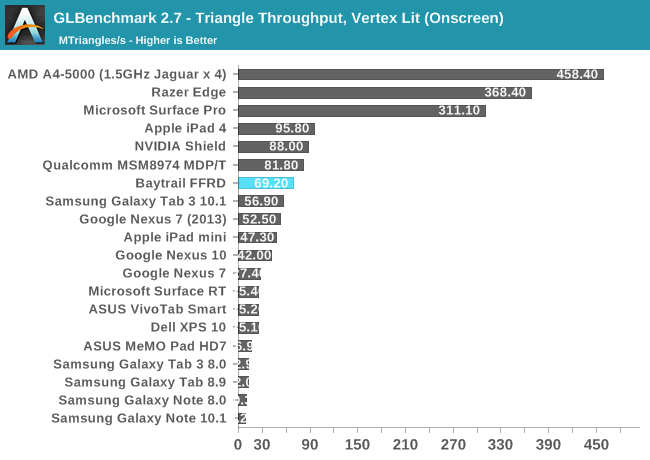
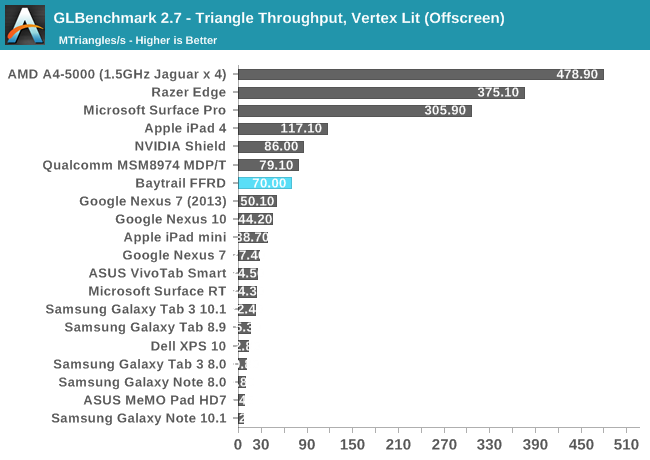
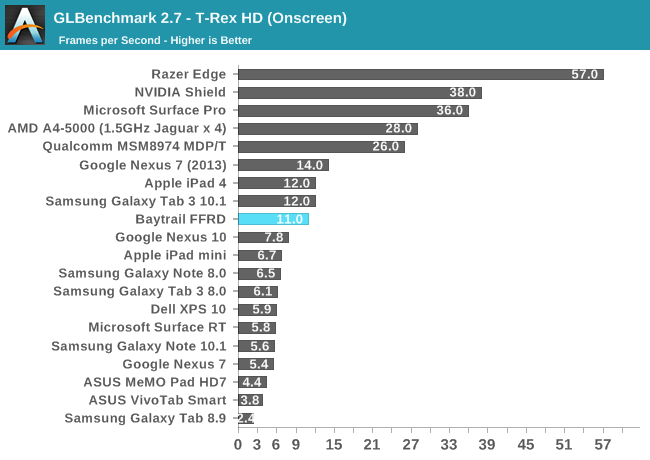
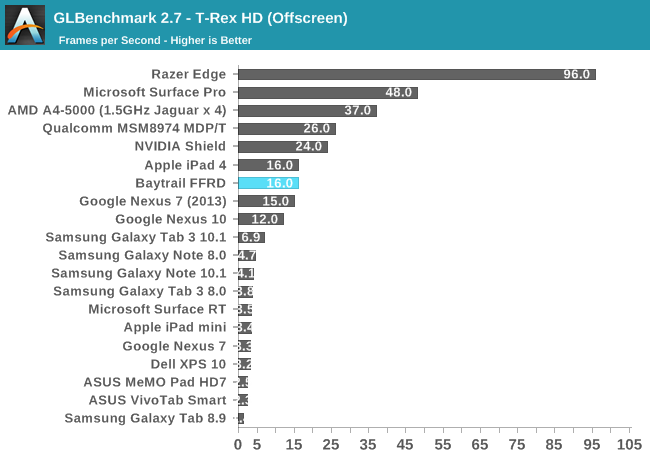
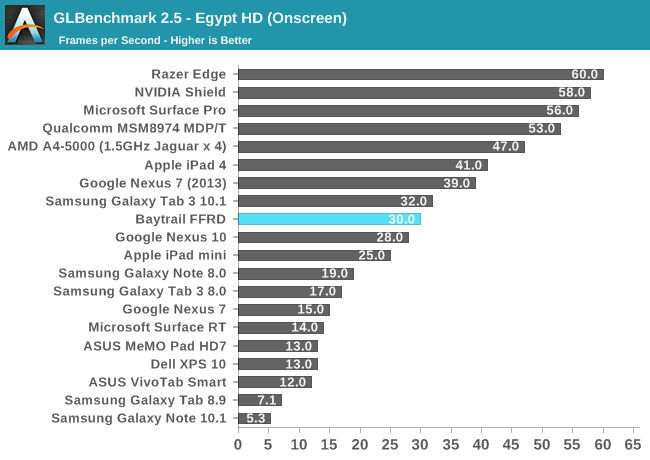
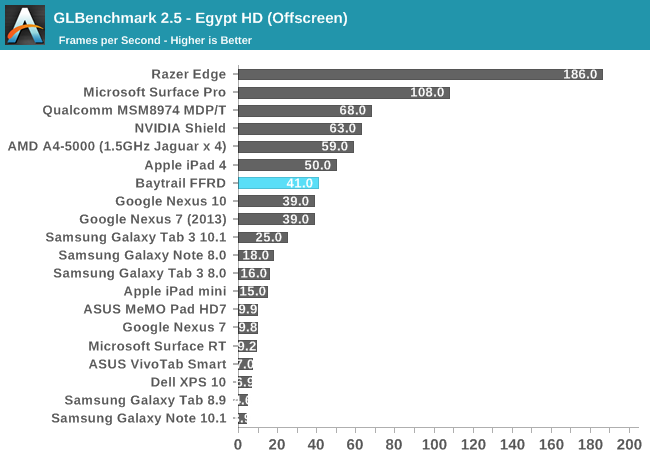
















190 Comments
View All Comments
ancientarcher - Friday, September 13, 2013 - link
well, there are two different things here1) whether it costs less vs clovertrail or is it just that the pricing is different: Clovertrail was on the 32nm fab, which is 4-6 years old by now, whereas 22nm trigate is only 2 years old. Apart from the age of the fab, double patterning matters - it means that you have double the number of steps as single patterning (in same stages). Even for relatively old fabs, double patterning will increase costs. Trigate also adds cost, not least in testing. I would bet my last penny that Baytrail is more expensive to manufacture than clovertrail, but Intel is pricing it lower (meaning lower margin) to not repeat past mistakes. Pricing Baytrail at $100+ will mean missing the market altogether, no matter how good the chip is.
&
2) costs versus the core series is irrelevant. The final costs depend primarily on the area of the chip. But Intel hasn't given out any details. WHY??? might I ask. Given the amount of graphics power and cores (4 vs 2 in clovertrail), I would think that the area of the Baytrail might be closer to 100mm^2. So, yea the core i7 processor of 177mm^2 is much larger but sells for $450 retail. Big difference...
By the time Intel is readying to put these in a smartphone, Qualcomm and the others will have products in 20nm (planar) with at least ~30% increase to CPU and GPU (maybe more in GPU on HSA capability) and Intel will fall behind again.
FAIL!!
zeo - Saturday, September 14, 2013 - link
Sorry but you lose the cost bet, for one thing you're forgetting the 22nm FAB reduces the amount of material needed for each chip and they can put more units on each wafer! So mass produced the cost of things like Tri-Gate get absorbed and negated... The increase in cost is also less now than when they first introduced the 22nm FAB. This isn't new technology anymore and the FAB yields are high enough to reduce costs now!Simple fact of the matter is we're already seeing pricing announced for Bay Trail based devices and they're starting well below what Clover Trail devices were introduced at!
The Asus T100 only has a starting price of $349, PCMag even did a benchmark (something to do with matching names and addresses using an algorithm), which took Clover Trail over 30 minutes but the Z3740 in the T100 finished it in just over 15 Minutes... and it includes the Keyboard dock in the pricing!
So the lower pricing and higher performance is a reality!
And no, Intel will already be putting these in Smart Phones by the time Qualcomm and others will have products in 20nm in actual products! Merrifield is getting a early 2014 release and besides, by the time they do push out 20nm into actual products Intel will already be getting ready to push out their 14nm Airmont update, which they already put on a accelerated schedule for rollout!
Really, it's understandable to be pessimistic, Intel took over 5 years to get serious with both mobile and the ATOM but believe it or not they're finally serious about it...
ollienightly - Sunday, September 15, 2013 - link
This is just silly. Intel already put almost twice as much transistors as CT+ in BT-T. The die size should be similar, thus invalidate your whole point of being cheaper. 32nm was back then much older tech than 22nm now. 32nm began shipping back in Q4 2009, CT was some 3-years later. Assuming BT-T ships this year, there's only a 2-year gap since intel's first 22nm offerings. So neither die size nor maturity is on BT-T's side. And the sheer cost in moving to 22nm will be the deciding factor. I wouldn't be surprised if the silicon costs twice as much to make and the total cost is 30% higher.Pricing has NOTHING to do with cost itself. BT-T is priced lower to remain competitive, that's all. Case in point, Haswell 4C-GT2 (177mm2, 4702M@2.2GHz) is more expensive than Haswell 2C-GT3 (181mm2, 4600M@2.9GHz), that is with the same process, TDP, time to market. And higher frequency / bigger die has higher defection rate. So there goes your cost theory.
zeo - Sunday, September 15, 2013 - link
Ship this year?Really? Toshiba, Dell and Asus are shipping Bay Trail based products in just over a month and you're still on whether they'll ship this year!
ollienightly - Sunday, September 15, 2013 - link
Also, keep in mind NVIDIA claims the per transistor cost stopped being competitive beyond 28nm-node. The general trend holds true for Intel. Even more so in CT v BT-T case since 22nm is still young whereas when CT announced, 32nm HKMG was widely used by every FAB in the world.zeo - Sunday, September 15, 2013 - link
Nonsense, first 22nm was started longer than 2 years ago. It only began producing shipping products 2 years ago but they were working on the technology much longer than that and it doesn't take long to perfect, which they have to do before they seriously move on to the next FAB advancement and they're already starting to get ready for that as well!Really, Intel is way ahead on many of these technologies. For example, Intel had been using HKMG at 45nm, long before ARM manufacturers caught up at 32nm, and Tri-Gate is already a well developed technology for Intel. Also, Bay Trail is a much simpler chip than the Core Processors. So it's doesn't require as high precision to make as the much more complex Core processors and thus they are a lot easier to get good yields for them!
And again, my point is the prices of actual devices coming out with Bay Trail is lower than the previous Clover Trail... So regardless of what you think Bay Trail is in fact cheaper than Clover Trail!
Not to mention Intel stated this months ago that Bay Trail will be cheaper than Clover Trail! Actual product pricing shows they kept their word!
monstercameron - Friday, September 13, 2013 - link
wow, do some research dude, oems don't care about power, case-in-point acer w700 and all those other i3/i5 tablets [ivybridge]. The a4-5000 could fit in a tablet just as comfortably.Nagorak - Wednesday, September 11, 2013 - link
In that case, why not just hold out for a Haswell based tablet?lmcd - Wednesday, September 11, 2013 - link
I still wonder what the picture would be like with comparable graphics. Too bad the wait still isn't over. And imagine what happens when Jaguar hits the HPL process Qualcomm got access to.Homeles - Wednesday, September 11, 2013 - link
Jaguar is on GloFo. Snapdragon 800 is on TSMC.